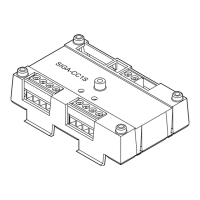© 2017 United Technologies Corporation 1 / 6 P/N 3100152-EN • REV 11 • ISS 16MAR17
SIGA-CC1S Auto-Sync Output Module
Installation Sheet
Description
The SIGA-CC1S Auto-Sync Output Module is an addressable
module that is used to connect the following circuits:
• Audible and visible notification appliance circuits
(synchronized or unsynchronized)
• Speaker circuits
• Two-way telephone communication circuits (three-state or
four-state)
Upon command from the loop controller, the module connects
the riser to the output circuit.
The module requires one address on the signaling line circuit
(SLC). Addresses are assigned electronically. There are no
address switches.
Diagnostic LEDs provide visible indication of the state of the
module through the cover plate:
• Normal: Green LED flashes
• Alarm/active: Red LED flashes
Personality codes
Use the personality codes described below to configure the
SIGA-CC1S module. See Table 1 for listing information.
Table 1: Personality codes
Code Description UL 864 CAN/ULC-
S527
EN 54-18
5 Signal - supervised
output (Class B)
6 Telephone - three-state
(Class B)
25 Signal – supervised auto
sync output (Class B)
26 Telephone - four-state
(Class B)
Personality code 5: Signal - supervised output (Class B).
Configures the SIGA-CC1S module as a riser selector for
audible and visible notification appliance circuits or for
single-channel audio circuits. The output circuit is monitored for
open or shorted wiring. If a short exists, the module will not
activate in order to prevent shorting the riser. The module will
activate once the short is cleared.
Personality code 6: Telephone - three-state (Class B).
Configures the module as a riser selector for a three-state
firefighter’s telephone. When a telephone handset is plugged
into its jack or lifted from its hook, the module generates its
own ring-tone signal, making a separate ring-tone riser
unnecessary. The module sends this signal to the control panel
to indicate the presence of an off-hook condition, and waits for
the system operator to respond to the call. When the system
operator responds, the ring-tone signal is disabled.
Personality code 25: Signal - supervised auto sync output
(Class B). Factory default. Configures the module to provide
synchronization of compatible fire alarm signals across multiple
zones. Operation is the same as Personality code 5 with the
addition that the module provides a sync signal for connecting
synchronized temporal horn/strobes.
Note: The use of nonsynchronous fire alarm signals with or
instead of compatible synchronized fire alarm signals does not
comply with UL 1971.
Personality code 26: Telephone - four-state (Class B).
Configures the module as a riser selector for a four-state
firefighter telephone. Operation is the same as Personality
code 6 except that the module can distinguish when a
telephone is off-hook and when the circuit is shorted, which
causes a trouble condition.

